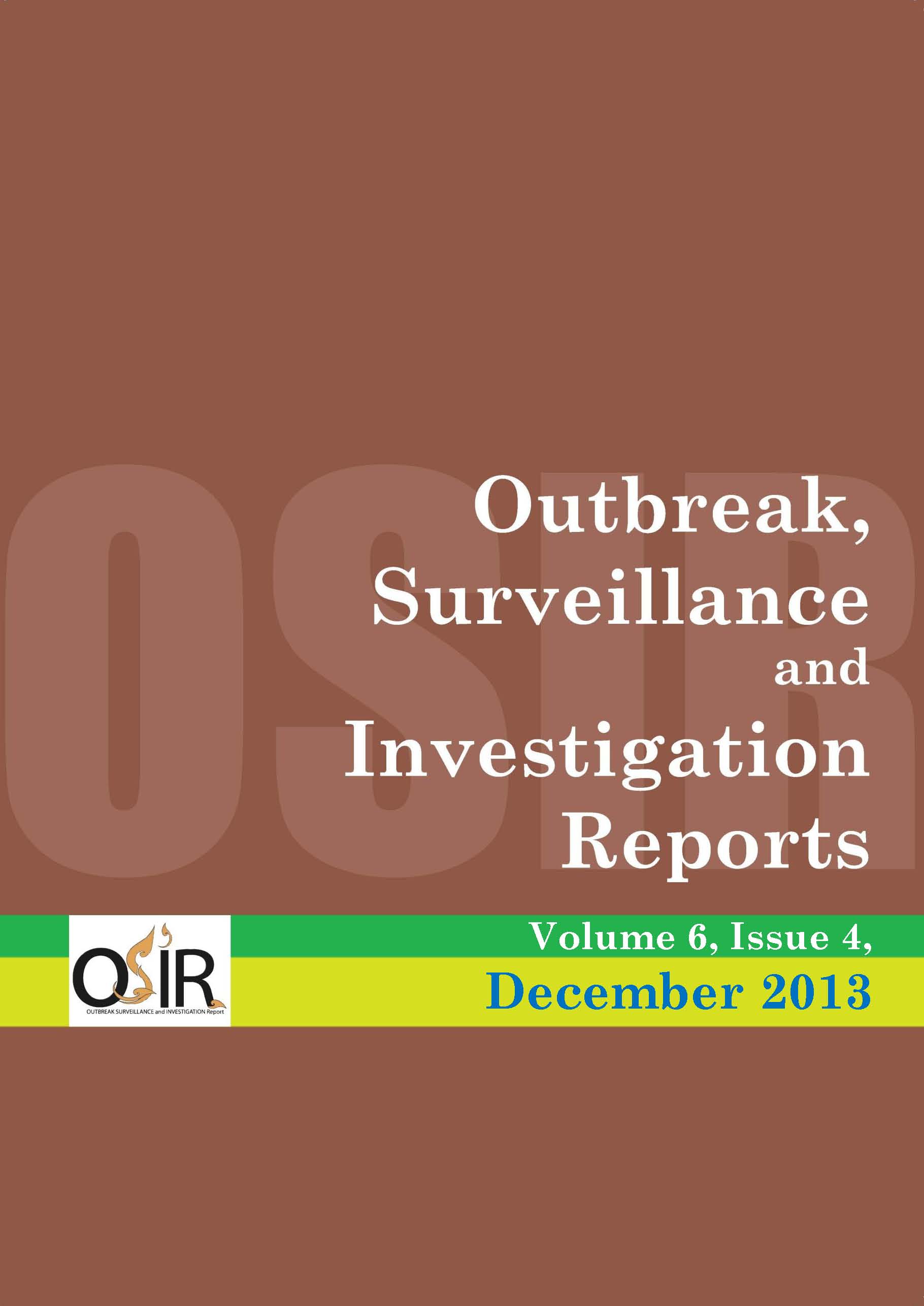Epidemiology of a Mumps Outbreak and Effect of Measles, Mumps and Rubella Vaccination in Nan Province, Thailand, June to December 2010
DOI:
https://doi.org/10.59096/osir.v6i4.263296Keywords:
mumps outbreak, MMR vaccination, Pua District, ThailandAbstract
In early September 2010, a nurse in Pua District Hospital observed an unusual increase in number of mumps cases and an outbreak investigation was conducted on 5 Oct 2010. This study described epidemiological characteristics of the outbreak as well as secondary attack rates and outcome of MMR vaccination campaign conducted during the outbreak. We reviewed medical records at Pua District Hospital and interviewed the cases’ family members, classmates and teachers. A clinical case was a person with acute parotitis or acute lymphadenitis at preauricular, submandibular or submental area with onset of illness from 1 Jun to 31 Dec 2010. A confirmed case was a clinical case who tested positive for mumps viral IgM by enzyme-linked immunosorbent assay (ELISA), mumps virus by polymerase chain reaction (PCR) or virus isolation. During the investigation period, we also conducted a single mass measles, mumps and rubella (MMR) vaccination campaign, targeting children aged 1-6 years in 10 sub-districts. From 1 Jun to 13 Oct 2010, 129 clinical cases (attack rate = 0.2%) were found in 11 out of 12 sub-districts. Of which, 70.4% were less than six years old children. Among 10 laboratory confirmed cases, six were positive for mumps IgM by ELISA and four positive for mumps virus by PCR, with one case revealed as genotype J. Secondary attack rate among 1-6 years old children was 31.4%. Attack rate among children aged 1-6 years during the pre-vaccination campaign period was 289.4 per 10,000 populations and decreased to 54.3 per 10,000 after the campaign. This investigation supported the Ministry of Public Health to change from using monovalent measles vaccine to MMR vaccine for 9-month old children in June 2010.
References
Plotkin SA, Rubin SA. Mumps vaccine. In: Plotkin SA, Orenstein WA, Offit PA, editors. Vaccines. 5th ed. Philadeiphia: Saunders;2008. p. 435-65.
World Health Organization. Immunization surveillance, assessment and monitoring: mumps. 2012. [cited 2012 Dec 22]. <http://www.who.int/immunization_monitoring/diseases/mumps/en/index.html>
Chokpaiboonkit K, Trishnananda M, Chunsuttiwat S, Tharmaphornpilas P, editors. Vaccine and immunization 2007. Nonthaburi: Ministry of Public Health; 2007. p. 13-24.
Heymann DL, editor. Control of communicable diseases manual. 18th ed. Washington: American Public Health Association; 2008.
Wikipedia. Pua District. 2012. [cited 2012 Apr 13]. <http://en.wikipedia.org/wiki/Pua_District>
Khampha P. Poverty rising in Thailand. 2001 Nov 19. [cited 2012 Apr 13]. <http://www.geocities.ws/chainat_prov/4412/THA-povertyrisingbywb.html>
Centers for Disease Control and Prevention. Epi Info. [cited 2013 Mar 5]. <http://wwwn.cdc.gov/epiinfo/html/prevVersion.htm>
Salmón-Mulanovich G, Utz G, Lescano AG, Bentzel DE, Blazes DL. Rapid response to a case of mumps: implications for preventing transmission at a medical research facility. Salud Publica Mex. 2009 Jan-Feb;51(1):34-8.
Carmody KA. Acute mumps. 2010. [cited 2010 Sep 23]. <http://emedicine.medscape.com/article/784603-overview>
Kutty PK, Kyaw MH, Dayan GH, Brady MT, Bocchini JA, Reef SE, et al. Guidance for isolation precautions for mumps in the United States: a review of the scientific basis for policy change. Clin Infect Dis. 2010 Jun 15;50(12):1619-28.
Fiebelkorn AP, Barskey A, Bellini W, Wallace G. Chapter 9: mumps. 2009. [cited 2011 Jan 15]. <http://www.cdc.gov/vaccines/pubs/surv-manual/chpt09-mumps.htm>
Niramitsantipong A, Chittaseni S, Sriwachirawat J, Pokawattana L, Pattamadilok S, Incomserb P, et al. Investigation of mumps outbreak in a private school, Bangkok, September 2007. Weekly Epidemiological Surveillance Report. 2010;41: 42-48.
Pattamadilok S, Incomserb P, Sungdee A, Niramitsantipong A, Lukebua A, Kumperasart S, et al. Characterization of mumps virus genotypes in Thailand during 2007-2008: first report. Bulletin of the Department of Medical Sciences. 2008;50(3): 197-206.
Downloads
Published
How to Cite
Issue
Section
License
Copyright (c) 2023 Outbreak, Surveillance, Investigation & Response (OSIR) Journal

This work is licensed under a Creative Commons Attribution-NonCommercial-NoDerivatives 4.0 International License.









